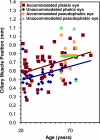Magnetic resonance imaging of the anteroposterior position and thickness of the aging, accommodating, phakic, and pseudophakic ciliary muscle
- PMID: 20152603
- PMCID: PMC2826892
- DOI: 10.1016/j.jcrs.2009.08.029
Magnetic resonance imaging of the anteroposterior position and thickness of the aging, accommodating, phakic, and pseudophakic ciliary muscle
Abstract
Purpose: To quantify accommodative and age-related changes in the anteroposterior position and thickness of the ciliary muscle in phakic and pseudophakic eyes.
Setting: Department of Surgery/Bioengineering, UMDNJ-Robert Wood Johnson Medical School, Piscataway; Institute of Ophthalmology and Visual Science UMDNJ-New Jersey Medical School, Newark, New Jersey; MRI Research, Inc., Middleburg Heights, Ohio, USA.
Methods: Magnetic resonance images were taken of phakic and pseudophakic eyes.
Results: The cohort comprised 32 phakic volunteers and 8 volunteers with a monocular intraocular lens (IOL) aged 22 to 91 years. No anteroposterior accommodative movement of the ciliary muscle apex occurred in either group. The muscle moved closer to the cornea with advancing age in phakic eyes; IOL implantation returned the muscle to a youthful position. An age-dependent increase in ciliary muscle anteroposterior thickness occurred that was not mitigated by IOL implantation. Muscle thickness increased with accommodation in only phakic eyes.
Conclusions: Presbyopia-correction strategies cannot rely on accommodative anterior movement of the ciliary muscle. Forces on the uvea by crystalline lens-pupillary margin contact may increase with accommodation and lens growth, producing accommodative and age-dependent increases in muscle thickness and significant age-dependent anterior muscle displacement. Intraocular lens implantation removed these forces, allowing choroidal elasticity to restore the muscle to a youthful position; however, the increase in thickness was permanent and likely due to an age-dependent increase in connective tissue. This supports the geometric theory of presbyopia development and that the mechanical forces in human accommodation and presbyopia are very different from those in the rhesus monkey model.
Copyright 2010 ASCRS and ESCRS. Published by Elsevier Inc. All rights reserved.
Figures



References
-
- Thornton SP. Lens implantation with restored accommodation. Curr Canadian Ophthalmic Prac. 1986;4:60, 62, 82.
-
- Findl O, Leydolt C. Meta-analysis of accommodating intraocular lenses. J Cataract Refract Surg. 2007;33:522–527. - PubMed
-
- Strenk SA, Strenk LM, Koretz JF. The mechanism of presbyopia. Prog Retin Eye Res. 2005;24:379–393. - PubMed
-
- Baikoff G, Lutun E, Wei J, Ferraz C. Anterior chamber optical coherence tomography study of human natural accommodation in a 19-year-old albino. J Cataract Refract Surg. 2004;30:696–701. - PubMed
Publication types
MeSH terms
Grants and funding
LinkOut - more resources
Full Text Sources
Other Literature Sources
Medical
Miscellaneous

